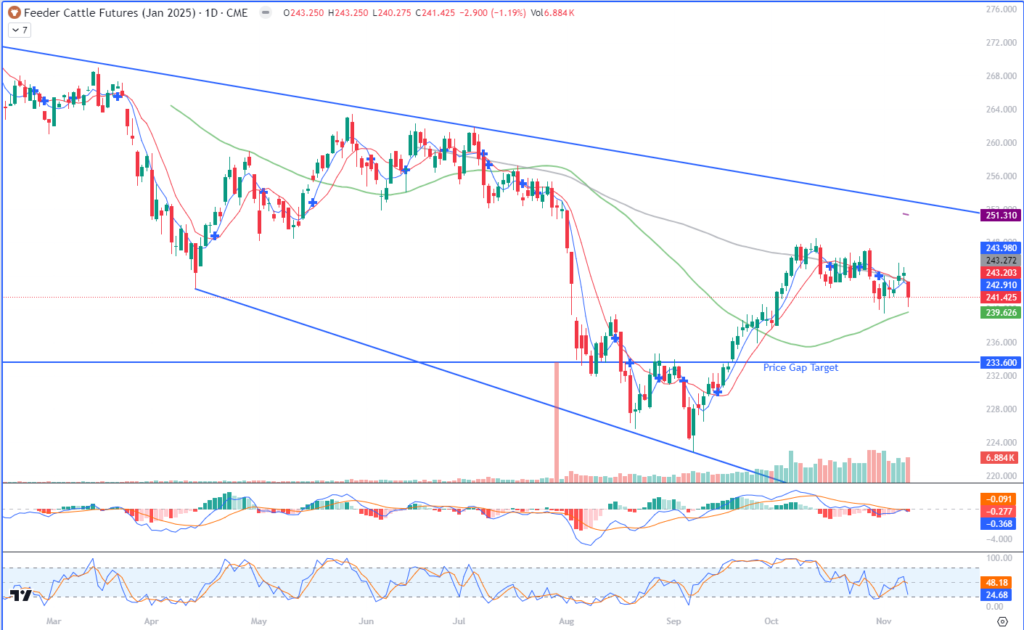The information and opinions expressed below are based on my analysis of price behavior and chart activity
Friday, November 8, 2024
January Feeder Cattle

January Feeder Cattle closed down 2.90 on the day and 1.775 lower for the week. As you can see by the chart above, the market has seemed to be trading in a range that’s been seemingly stick on both sides of the 100-day moving average for the past month or so. This was the lowest weekly close since the week that began on September 23rd. There did appear to be a bit of buying interest today following today’s sharply lower open, but to my eye that was short traders taking profit to end the week. There is a gap on the daily chart from September 18-19 and the lower end of that gap is at 233.60 and indicated by the blue horizontal line on the chart. To my eye, that’s where the market is headed. Most (but not all) of the time the futures markets tend to go back and fill gaps. I find that to be most true when the contract is trading as the front month, or most actively traded contract, as the January contract is now. The market appears to have been in a downtrend all year, as you may notice by the blue lines drawn off the significant highs and the lows of the year. The price activity in Feeders can be very volatile and I believe that to be because this is a less actively traded market, compared to Live Cattle or Corn, for example. The MACD seems to be in neutral to negative territory (1st subgraph) and the Stochastics (2nd subgraph) have been chopping lower since the middle of October. As I stated up above, I think the Feeders are headed lower to fill the gap at 233.60. If the momentum accelerates, they may even push to new contract lows, continuing the pattern that’s been in place all year. Producers that wish to simply hedge against that risk may do well to consider January 233.00 Put options, which closed today at 2.925 or $1,462.50 (plus commissions and fees) If you’re looking for something a bit closer to the market, or perhaps less expensive, the 240 puts could be spread against the 235 puts for 1.85 at today’s closing prices, or $925 plus commission and fees. Aggressive and well margined producers could also consider selling a Call option above the market (Jan 250 Calls closed at 2.45, or $1,225 plus commissions and fees) to actually gain $300 in their account (before commissions and fees) when putting the trade on as a 3-way spread. However, this adds a margin requirement and additional risk to the trade that may not work for your situation. If the market goes lower, as I think it will, the sold Call should erode in value and the purchased Put Spread should gain value. If the market goes higher, the opposite will happen and your account will likely incur additional margin requirements or capital. Please contact me directly to determine if this is suitable for your situation, account size and risk tolerance level.
Jefferson Fosse Walsh Trading
Direct 312 957 8248 Toll Free 800 556 9411
jfosse@walshtrading.com www.walshtrading.com
Walsh Trading, Inc. is registered as a Guaranteed Introducing Broker with the Commodity Futures Trading Commission and an NFA Member.
Futures and options trading involves substantial risk and is not suitable for all investors. Therefore, individuals should carefully consider their financial condition in deciding whether to trade. Option traders should be aware that the exercise of a long option will result in a futures position. The valuation of futures and options may fluctuate, and as a result, clients may lose more than their original investment. The information contained on this site is the opinion of the writer or was obtained from sources cited within the commentary. The impact on market prices due to seasonal or market cycles and current news events may already be reflected in market prices. PAST PERFORMANCE IS NOT NECESSARILY INDICATIVE OF FUTURE RESULTS. All information, communications, publications, and reports, including this specific material, used and distributed by Walsh Trading, Inc. (“WTI”) shall be construed as a solicitation for entering into a derivatives transaction. WTI does not distribute research reports, employ research analysts, or maintain a research department as defined in CFTC Regulation 1.71.
